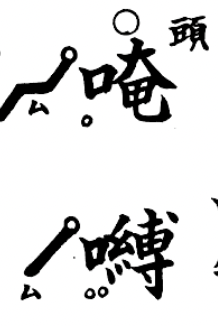The neumatic notation - the Buddhist of smooth melodic movement
Western music uses staff notation while Chinese music uses solfege or ideogram notation. These two notations have a common point one symbol represents a pitch. The player perceives the pitches block by block, one note or chord at a time and one after. However, some Buddhist chanting music uses curved lines to notate the music, and emphasise the contour of the voice. It is similar to the western glissando but not in a linear way. The connection between of each text is smooth and flowing.
Japanese Shōmyō
In Japanese Shōmyō, a type of Buddhist chant in Japan, they have a contrasting notation method to the West. The neumatic notation, generally known as hakase (-bakase). straight and curved lines (Tokita, 2008). Same with the Western neume, these notations lack any systematic way of indicating pitch. The lines appear to represent the up-and-down movement of the vocal melody in a simple visual manner.
 |
| A Shōmyō hakase score (Tokita,2008) |
 |
| A "Five- tone" notation excerpt. (Tokita,2008) |


Comments
Post a Comment